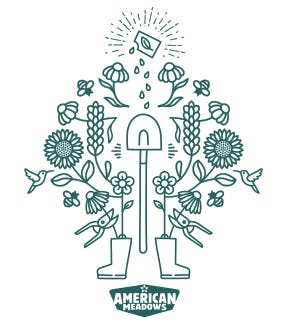Part Of The American Meadows Meadowscaping Learning Center
Michigan Native Plants, State Flowers & State Bird
Native plants are adaptable, low-maintenance, and beautiful. They are the best choice for habitat-friendly gardens and thriving ecosystems. Find top picks for native plants in your state - and learn about your state bird and state flowers!
Follow Along With More Of Our Guides
Hello native plant enthusiasts! In the list below, you will find popular native plants and wildflower seeds, available from American Meadows, that have a native distribution in your state. You’ll also find information about your state bird, state flower, and state wildflower!
About Our Native Plant Lists For Each State
- The links will take you to a single plant or seed selection for the plant listed -- but in many cases, we offer multiple cultivars for each plant, and we may offer both seeds and potted plants to grow the plant on your list. This list is a work in progress as we expand our native plant educational resources.
- The list for your state is a great place for getting started with native plants - but it is by no means a comprehensive listing of the hundreds of native plants growing in each state.
Michigan Native Plants
Grow our Native Midwest Wildflower Seed Mix
Virginia Bluebells (Mertensia virginica)
Showy Goldenrod (Solidago speciosa)
Wrinkleleaf Goldenrod (Solidago rugosa)
Perennial Lupine (Lupinus perennis)
Black Eyed Susan (Rudbeckia fulgida)
Black Eyed Susan or Gloriosa Daisy (Rudbeckia hirta)
Purple Coneflower (Echinacea purpurea)
Pale Purple Coneflower (Echinacea pallida)
Yellow Prairie Coneflower (Ratibida columnifera)
Gray Headed Coneflower (Ratibida pinnata)
Butterfly Weed (Asclepias tuberosa)
Swamp Milkweed (Asclepias incarnata)
Common Milkweed (Asclepias syriaca)
White Trillium (Trillium grandiflorum)
Red Trillium (Trillium erectum)
Painted Trillium (Trillium undulatum)
Long Beaked Sedge (Carex sprengelii)
White Tinged Sedge (Carex albicans)
Firewheel (Gaillardia pulchella)
Blanket Flower (Gaillardia aristata)
Wild Strawberry (Fragaria virginiana)
Lowbush Blueberry (Vaccinium angustifolium)
Plains Coreopsis (Coreopsis tinctoria)
Lanceleaf Coreopsis (Coreopsis lanceolata)
Wild Bergamot (Monarda fistulosa)
Wild Geranium (Geranium maculatum)
Elderberry (Sambucus canadensis)
Phlox divaricata (Woodland Phlox)
Obedient Plant (Physostegia virginiana)
Red Cardinal Flower (Lobelia cardinalis)
Blazing Star (Liatris spicata)
Prairie Blazing Star (Liatris pycnostachya)
Meadow Anemone (Anemone canadensis)
Lacy Phacelia (Phacelia tanacetifolia)
Anise Hyssop (Agastache foeniculum)
Bottlebrush Grass (Elymus hystrix)
Big Bluestem (Andropogon gerardii)
Muhly Grass (Muhlenbergia capillaris)
Little Bluestem (Schizachyrium scoparium)
Tufted Hair Grass (Deschampsia cespitosa)
Northern Sea Oats (Chasmanthium latifolium)
Yellow Prairie Grass (Sorghastrum nutans)
Smooth Blue Aster (Symphyotrichum laeve)
New England Aster (Symphyotrichum novae-angliae)
Sky Blue Aster (Symphyotrichum oolentangiense)
Common White Yarrow (Achillea millefolium)
Heliopsis (Heliopsis helianthoides)
Purple Prairie Clover (Dalea purpurea)
Michigan State Bird, State Flower & State Wildflower

Robin ~ Turdus migratorius
Throughout the central and northern states, the return of the Robin in March is a regular topic of conversation. It means that spring is in the air, heralded by a reliable friend. Within a few days after the males appear in northern yards, the females arrive. After laying a platform of twigs and grass, the female builds up the walls with mud and more grass. While her mate stands guard against invaders, the female incubates the three or four eggs for eleven to fourteen days.
Apple Blossom ~ Pyrus coronaria
The Apple Blossom's bright pink buds, opening to fragrant white, golden-centered flowers, are lovely to look upon. These blossoms are an unfailing foraging ground for bees, and over much of the country, a welcome symbol of advancing springtime. The five pistils and the many stamens with their yellow pollen grow in the center of the five-petaled flower. Bees and other insects carry the pollen grains from flower to flower. Botanically, apples belong to the rose family which includes most of our show flowering trees--cherry, plum, peach, pear, quince, and crabapple.
From The Wildflowers of the 50 States U.S. stamps issued July 24, 1992:

About Native Plants
- Native plants are essential for healthy ecosystems and habitat. They have evolved over time with local wildlife and climate conditions. Many pollinators have special relationships with native plants that they rely on for survival. For instance, some bees are specialists and require nectar and pollen from specific native plants to survive; and butterflies and moths often have specific host plants needed to nourish their caterpillars. For example, Asclepias (Milkweed or Butterfly Weed) is the host plant required for Monarch caterpillars to survive and grow into Monarch Butterflies!
- It’s OK to grow native plants in your yard that may not be native to your state or region. Remember – just because a plant is not native, does not necessarily mean that it is invasive or harmful. In fact, growing well-behaved introduced plants that are suited to your growing conditions can still provide many benefits to your yard (especially when compared to a traditional turf lawn).
- Know before you grow – It's always a good idea to learn what plants are native, well-behaved, and invasive or aggressive in your region before digging in.
- Learn More: All About Native Plants
Explore our full selection of native plants and seeds
More From Our Learning Center

